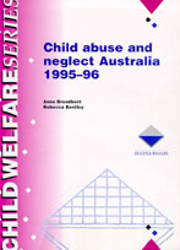Summary
This report presents statistics on notifications of child abuse and neglect made to State and Territory community service departments in the 1995-96 financial year. It also provides data on finalised investigations and substantiated notifications of abuse and neglect and on children who were the subject of these finalised investigations and substantiations. It does not provide details about all child abuse and neglect in Australia as an unknown number of occurrences of abuse and neglect are not reported to community service departments. The main points to be noted from the statistics presented in this report are:
- In 1995-96 State and Territory community service departments recorded 91,734 notifications of child abuse and neglect, of which 74% were investigated and 14% were dealt with by means other than investigation (such as referral). The remaining 12% were not investigated or dealt with by any means; these include notifications where there was insufficient information to allow follow-up and notifications where action or investigation was not considered necessary.
- Of the 67,816 notifications that were investigated during the year, 61,383 (91%) were finalised by 31 August 1996. Of those finalised investigations 49% were substantiated, 47% were unsubstantiated and 4% had an outcome of 'child at risk'. The 29,833 substantiations consisted of 8,467 physical abuse substantiations (28%), 9,265 emotional abuse substantiations (31%), 4,802 sexual abuse substantiations (16%) and 7,299 neglect substantiations (25%).
- Overall, 53% of substantiations involved female children, although this varied across age groups and the types of abuse and neglect. Sexual abuse was far more likely to involve female children, particularly in the older age groups.
- Some children may be the subject of more than one notification, investigation or substantiation of child abuse or neglect in a year. In 1995-96, 71,766 children were the subject of a notification, 51,133 the subject of a finalised investigation and 25,558 the subject of a substantiation. This represents 16.3 children per 1,000 aged 0-16 years in the population who were the subject of a child abuse and neglect notification, 11.6 per 1,000 who were the subject of a finalised investigation and 5.8 per 1,000 who were the subject of a substantiation.
- Aboriginal and Torres Strait Islander children are over-represented in the child abuse and neglect statistics in 1995-96. The rate for Aboriginal and Torres Strait Islander children in notifications was 42.3 per 1,000 children aged 0-16 years, compared to 15.5 per 1,000 for other children. Similarly, 34.4 per 1,000 Aboriginal and Torres Strait Islander children were involved in a finalised investigation and 18.0 per 1,000 were the subject of a substantiation. The respective rates for other children were 10.9 and 5.4 per 1,000. Aboriginal and Torres Strait Islander children are particularly over-represented in neglect substantiations.
- In 1995-96 the most common sources of notifications of abuse and neglect were friends/neighbours, parents/guardians, school personnel and the police. Notifications made by the police or the subject child were more likely to be substantiated than those from other sources. In particular a low proportion of notifications from anonymous sources were substantiated.
- Available data from the States and Territories indicate that in 71% of substantiations the person believed responsible for the abuse or neglect was the natural parent. This is not surprising given that the statistics on child abuse and neglect include only those incidences involving protective issues for the child (that is, where the child's parents or guardians have been responsible for the abuse or neglect, or unable or unwilling to protect the child from abuse or neglect).
- Where States and Territories could provide data on the type of family in which the child was residing, the statistics show that, in 1995-96, 40% of emotional abuse substantiations, 32% of sexual abuse substantiations and 51% of neglect substantiations involved a child from a single female parent family. Thirty-four per cent of physical abuse substantiations involved a child from a 'two parent-natural' family. In interpreting these figures it should be noted that the factors associated with child abuse and neglect are complex and no single factor, such as the type of family structure in which a child lives, can fully explain why child abuse and neglect occurs.
Preliminary material (27K PDF): Contributing departments; List of tables; List of figures; Preface
Part A: Overview (1-5: 81K PDF; 6-8: 36K PDF)
1. Introduction
2. Background
3. Scope and coverage
- Scope and coverage of data in this report
- Changes from previous years
4. Defining child abuse and neglect
5. Reporting of child abuse and neglect
- Overview
- Mandatory reporting
- Role of the police
6. The Commonwealth's role in child abuse and neglect
7. Factors often associated with child abuse and neglect
8. Overview of the processes of notification, investigation and substantiation of abuse and neglect
- Notifications
- Investigations
- Substantiations
- Child at risk
- No abuse or neglect (unsubstantiated)
Part B: Analysis
9. Child abuse and neglect 1995-96 (86K PDF)
- Overview
- Notifications
- Finalised investigations
- Substantiations
- Children who were the subject of notifications, finalised investigations and substantiations in 1995-96
- Rates of abuse and neglect in the population
- Source of notifications
- Person believed responsible-relationship to child
- Type of family in which the child was residing
- Injury and harm
10. Detailed tables (99K PDF)
- Finalised investigations and substantiations by age and sex of child
- Change over time-substantiations and 'child at risk'
- Children who were the subject of notifications, finalised investigations and substantiations in 1995-96
- Rates of abuse and neglect in the population
- Source of notifications
- Type of family in which the child was residing
- Injury and harm
End matter (34K PDF): Glossary; Bibliography
Appendixes
Appendix 1: Legislation relevant to child abuse and neglect 1995-96
Appendix 2: Mandatory reporting requirements in each State and Territory
Appendix 3: Related AIHW publications
Appendix 4: Abbreviations



